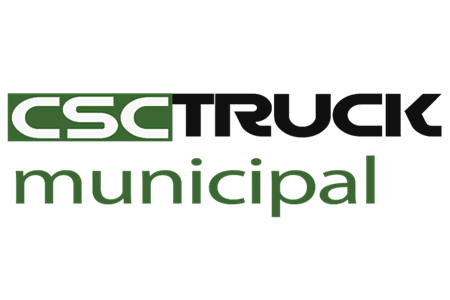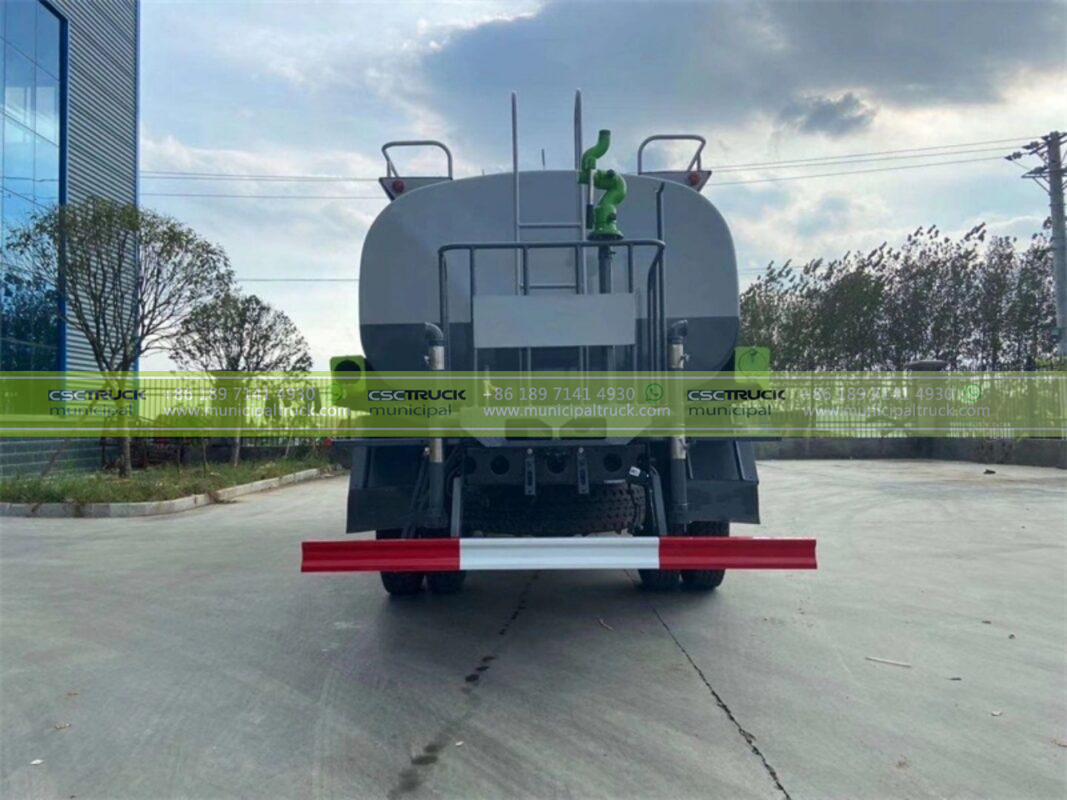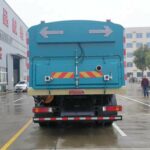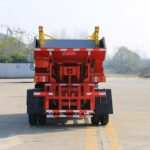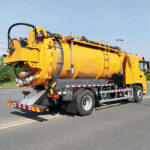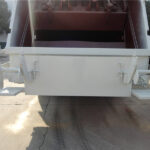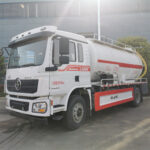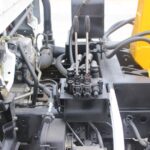The Unseen Lever of Hydro-Efficiency
In the demanding arena of municipal and industrial cleaning, the water jetting truck stands as a formidable force, harnessing the sheer power of pressurized water to scour sewer lines, dissolve stubborn blockages, and restore flow. Yet, beneath the roaring pumps and high-pressure hoses lies a critical, often underestimated, component: the nozzle. Far more than a simple orifice, the nozzle is the final arbiter of how hydraulic energy transforms into cleaning action. Selecting the optimal nozzle configuration is not a minor detail; it is the pivotal decision separating operational mastery from wasteful inefficiency. The wrong nozzle squanders water, prolongs job times, risks infrastructure damage, and inflates costs. The right configuration, however, acts as a force multiplier, maximizing cleaning efficacy while minimizing resource consumption and operational downtime. Understanding the intricate interplay between nozzle design, application demands, and desired outcomes is fundamental to unlocking the true potential of any vacuum truck-mounted jetting system or standalone water sprayer truck.
1. Core Principles: The Hydrodynamics of Effective Nozzle Design
Transforming Pressure into Purposeful Power
The efficiency of any water jetting nozzle hinges on its mastery of fundamental fluid dynamics. Key principles govern its performance:
- Pressure, Flow, and Impact Force: High water pressure (measured in PSI or bar) is crucial for penetrating tough deposits and overcoming friction losses in long hoses. However, pressure alone is meaningless without adequate water flow (measured in GPM or LPM). The true measure of cleaning power is impact force (pounds or kilograms of force), calculated mathematically as (Flow x Pressure) / 1080 (imperial) or derived from dynamic pressure equations. Effective nozzles maximize impact force for a given pump output.
- Orifice Dynamics: The size, shape, number, and orientation of the nozzle’s orifices dictate everything. Smaller orifices increase jet velocity for deeper penetration but reduce flow and recoil dramatically. Larger orifices handle higher flows but produce slower, less penetrating jets. Precision machining is vital to prevent energy-sapping turbulence and uneven wear.
- Thrust, Recoil, and Maneuverability: Jets exiting the nozzle create reactive thrust according to Newton’s Third Law. Forward-facing jets pull the hose downstream (useful for self-propelling), while rear-facing jets create powerful recoil forces that the operator or hose handling system must counteract. Nozzle configurations strategically balance these forces for optimal hose advancement, positioning control, and operator safety. Poorly managed recoil leads to operator fatigue, erratic hose movement, and potential injury.
- Spray Pattern Geometry: The shape of the water fan – fan spray nozzles, rotary jetting nozzles, or solid stream nozzles – determines the cleaning mechanism (impact, scouring, cutting) and the area covered per pass. This directly influences cleaning speed and water utilization efficiency.
2. The Arsenal: Primary Nozzle Types & Their Dominant Applications
Matching the Tool to the Task
Selecting the optimal nozzle requires understanding the distinct capabilities and ideal use cases of each primary configuration:
- Forward-Jetting Nozzles (Battering Rams): Featuring jets angled predominantly forward (0° to 15° off-axis), these configurations generate powerful forward thrust, efficiently propelling the hose through pipelines. The ballistic impact of the leading jets excels at breaking through heavy obstructions, compacted debris, and root masses. They minimize recoil, enhancing operator control during initial penetration and heavy cutting phases. Their limitation lies in limited radial cleaning coverage behind the leading edge, often necessitating subsequent passes with other nozzle types.
- Rear-Jetting Nozzles (Scouring Masters): Designed with jets angled sharply rearward (typically 25° to 45° off-axis), these nozzles prioritize radial cleaning coverage. The rearward jets scour the pipe walls as the hose is retrieved, effectively removing grease, sediment, scale, and biofilms over a wider area. However, this design generates significant rearward recoil, requiring substantial operator strength or mechanical hose retrieval systems (common on vacuum truck setups) to manage effectively. Used alone, they lack the forward thrust for penetrating blockages.
- Combination Nozzles (The Strategic Hybrid): Representing the most versatile and commonly deployed configuration, combination nozzles intelligently blend forward and rear jets. Typically, 2-4 powerful forward jets provide the necessary thrust for penetration and pushing debris, while 2-4 angled rear jets ensure comprehensive pipe wall cleaning during retrieval. This balanced approach offers a compelling compromise between penetration power and cleaning coverage, significantly reducing the need for frequent nozzle changes on most general maintenance and cleaning jobs – the workhorse choice for many municipal truck fleets.
- Rotary Jetting Nozzles (The Dynamic Cleaners): Incorporating a rotating head driven by strategically angled jets, these nozzles deliver a high-impact, spiraling cleaning pattern. The rotation ensures uniform coverage of the pipe circumference with intense, focused energy, making them exceptionally effective against tough, adherent deposits like hardened grease, mineral scale (calcite, rust), and cementitious residues that static jets might glaze over. While offering superior cleaning per pass, they generate complex thrust/recoil vectors and generally require higher flow rates than static nozzles for optimal rotation speed. Their moving parts also demand more rigorous maintenance.
3. Specialized Configurations & Advanced Features
Precision Solutions for Complex Challenges
Beyond the primary types, specialized nozzles tackle niche applications and enhance control:
- Dual-Pattern Nozzles (Adaptive Tools): These innovative nozzles allow operators to switch between configurations (e.g., forward jet to combination jet) downstream, typically via a control cable running through the hose. This eliminates the need to retrieve the entire hose assembly for a nozzle change when encountering varying blockage types or transitioning from penetration to wall cleaning within the same run, offering tremendous operational flexibility and time savings on complex jobs.
- Fan Spray Nozzles (Surface Specialists): While less common for pipe cleaning, wide-angle fan spray nozzles are invaluable for surface applications often handled by water sprayer trucks, such as flushing catch basins, cleaning trench drains, or pre-soaking large areas of pavement before mechanical sweeping. They distribute water over a broad area efficiently but lack the penetrating power of focused jets for pipe work.
- Chain Reaction Nozzles (Root Cutters): Featuring hardened steel chains attached near the nozzle body, these specialized tools are designed explicitly for cutting invasive tree roots within pipes. The chains are whipped violently by the escaping jets, creating a cutting/slicing action that complements the hydraulic force. They are essential for root removal but generate extreme recoil and require careful operation.
- Camera-Integrated Nozzles (Seeing is Cleaning): Combining a high-pressure nozzle with a real-time inspection camera provides immediate visual feedback during cleaning. Operators can precisely target blockages, verify cleaning effectiveness on the first pass, identify collateral damage, and document conditions, drastically improving cleaning precision and reducing unnecessary repetitive jetting.
4. Strategic Selection: Key Variables Dictating Optimal Configuration
The Decision Matrix for Peak Performance
Choosing the perfect nozzle is a calculated decision based on specific job parameters:
- Nature of the Obstruction/Debris: Is it a solid blockage (roots, collapsed pipe, rags)? Choose forward-jetting nozzles or rotary jetting nozzles. Is it adhering scale or grease? Rotary nozzles or rear-jetting nozzles excel. Is it loose sediment and silt? Combination nozzles or rear-jetting nozzles are efficient. Chain reaction nozzles are reserved for roots.
- Pipe Diameter and Material: Smaller pipes demand smaller diameter nozzles with fewer jets to maintain sufficient flow velocity and impact. Larger pipes require nozzles capable of greater coverage (more jets, potentially rotation). Consider potential abrasion on softer pipes (clay, PVC) – aggressive nozzles might damage them. Rotary jetting nozzles require adequate clearance to rotate freely.
- Pump Capacity (Flow & Pressure): The nozzle must be matched to the truck’s pump capabilities. Exceeding the recommended flow for a nozzle orifice causes catastrophic pressure drop and loss of impact force. Undersized orifices strain the pump and limit achievable pressure. Consult manufacturer performance charts to select nozzles operating within the pump’s optimal range. Rotary nozzles often require higher flows.
- Hose Length and Diameter: Long hose runs or smaller diameter hoses create significant friction loss, reducing pressure and flow at the nozzle. This necessitates careful nozzle selection to compensate (sometimes requiring slightly larger orifices than ideal for short runs) and may limit the viability of high-flow configurations like certain rotary jetting nozzles on very long pushes with small hose.
- Access and Retrieval Method: Consider the practicality of hose handling. Jobs requiring extensive manual hose pushing benefit greatly from the forward thrust of forward-jetting nozzles. Operations using vacuum truck-powered hose reels can more readily manage the recoil of potent rear-jetting or rotary nozzles. Dual-pattern nozzles add flexibility in confined access points.
5. Integration and Optimization: Beyond the Nozzle Tip
Maximizing the System for the Municipal Mission
Implementing the optimal nozzle configuration is just one element of a holistic efficiency strategy for water jetting truck fleets, particularly critical for resource-constrained municipal truck operations:
- Pre-Job Inspection & Targeting: Utilize CCTV inspection before jetting to accurately identify the blockage type, location, and pipe condition. This intelligence allows for selecting the right nozzle and approach immediately, avoiding ineffective methods and repeat visits. It also prevents jetting unstable pipes.
- Operator Training and Expertise: The best nozzle is ineffective in untrained hands. Comprehensive training on hydrodynamics, nozzle characteristics, safe handling techniques (especially managing recoil), and situational awareness is paramount. Operators must understand why a specific nozzle is chosen and how to deploy it effectively.
- Preventive Maintenance Regimen: Nozzles are high-wear items. Establish a rigorous schedule for inspecting orifices (for wear, chips, or clogging), checking moving parts on rotary jetting nozzles, and replacing components before performance degrades. Worn nozzles drastically reduce impact force and waste water. Keep spares readily available on the water sprayer truck.
- System Monitoring and Data: Employ pressure gauges at the pump and downstream near the nozzle (if possible) to monitor actual operating pressure. Track water consumption per job. Analyze job times and success rates relative to nozzle selection. This data drives continuous improvement in nozzle strategy and overall water jetting truck deployment efficiency.
- Synergy with Supporting Assets: Recognize how the jetter integrates with other fleet assets. Using a vacuum truck concurrently for debris removal prevents re-blockage and allows immediate verification of cleaning effectiveness. Combining jetting with robotic cutters or inspection units on larger projects creates a powerful, multi-tool approach. For the municipal truck fleet manager, viewing the nozzle not as an isolated component, but as the critical interface connecting pump power to pipeline problem-solving, is the key to unlocking sustained operational excellence, cost control, and infrastructure longevity. The precision pulse begins at the tip.
